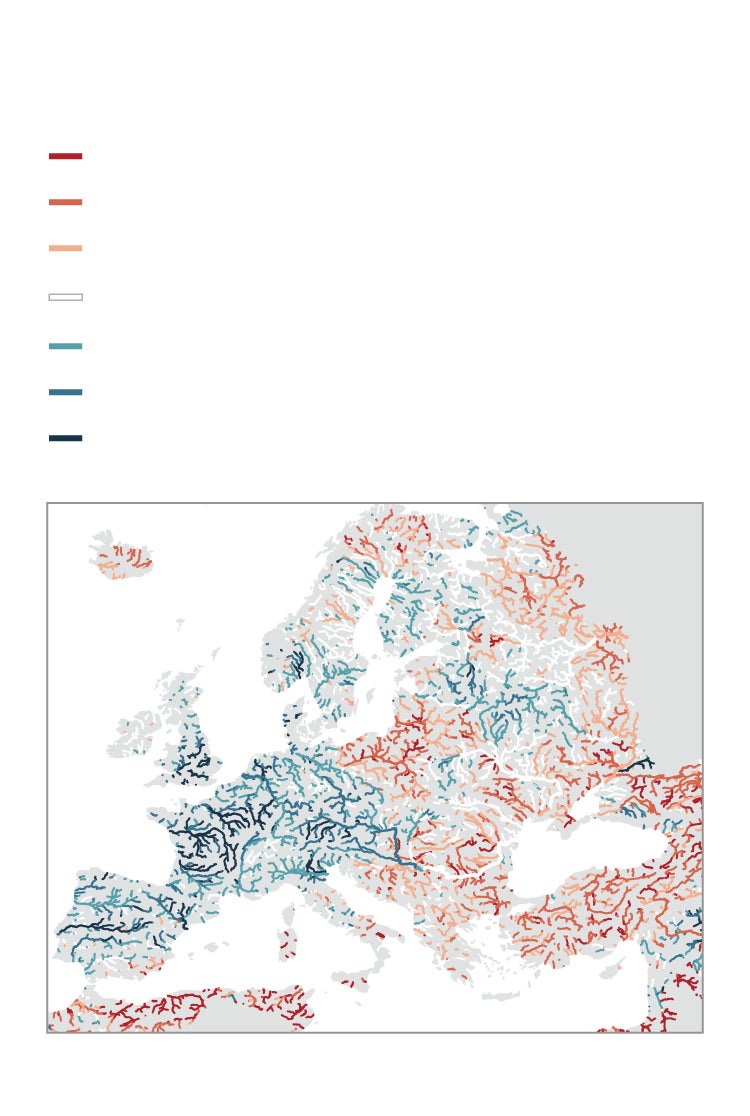

Sections
Highlight

Widespread flooding and abnormally high river flows during 2024 in Western Europe have prompted a wake-up call from the experts at the European climate change monitoring service, Copernicus (CS3). These climate change and weather experts carry out a yearly assessment reporting on climate change in collaboration with the World Meteorological Organization (WMO, an agency within the United Nations). They have issued a warning in their 2024 report: "Europe is the fastest-warming continent and the repercussions here are obvious."
Although 2024, as the latest temperature report has shown, will go down in history as the hottest year on record, it is the stark contrasts that define how the weather behaves in the context of global warming.
The scientists who produced this year's report highlight how the reality of the climate is splitting Europe in two, with a "very high contrast" between east and west. The first, extremely dry with long heat waves and rivers at minimum levels. The second, including Spain, with above-average river flows, often threatening and even causing floods, with intensely abnormal rainfall and wetter soil.

Extremos en el caudal medio anual de los ríos en 2024
Más bajo
Mucho más bajo que el promedio
Más bajo que el promedio
Cercano al promedio
Más alto que el promedio
Mucho más alto que el promedio
Más alto
Fuente: Copernicus (CS3)

Extremos en el caudal medio anual de los ríos en 2024
Más bajo
Mucho más bajo que el promedio
Más bajo que el promedio
Cercano al promedio
Más alto que el promedio
Mucho más alto que el promedio
Más alto
Fuente: Copernicus (CS3)

Extremos en el caudal medio anual de los ríos en 2024
Más bajo que el promedio
Más bajo
Mucho más bajo que el promedio
Cercano al promedio
Más alto que el promedio
Mucho más alto que el promedio
Más alto
Fuente: Copernicus (CS3)
They go on to point out that in 2024 we have experienced "the most widespread floods" recorded in over a decade, or rather since 2013, affecting the area stretching from Spain and Italy to the north of the Scandinavian peninsula. For this part of Europe the average rainfall puts 2024 as the wettest year since 1979 and one of the ten wettest since 1950.
It goes without saying that, when referring to flooding incidents, the catastrophe experienced in Valencia last October stands out in the balance sheet drawn up by the CS3 and the WMO for last year. Of the 335 flood victims recorded by the WMO in Western Europe, 227 are from the Valencian region of Spain.
In terms of the overall number of people affected in one way or another by floods, the report puts the total at 413,000 people across Europe. A month before the disaster in Valencia, Storm Boris affected hundreds of thousands of people in parts of Germany, Poland, Austria, Hungary, the Czech Republic, Slovakia, Romania and Italy.
Celeste Saulo
WMO
To have reached this state of affairs we only need look at how our rivers were doing during 2024 as that is very telling. River levels in Western Europe remained above average in March, April and May. Moreover, 30% of the river network exceeded the "high" flood threshold during the year, while 12% exceeded the "severe" level.
To explain these meteorological terms more simply, the report gives examples. The Thames in the UK remained above average for most of the year, with record flow figures from March to October.
In France, the Loire maintained an abnormally high flow throughout the year, with record highs at certain points. The report also highlights the behaviour of rivers in the Iberian peninsula, where they went from below-average to well above-average records, and even to historic levels, as happened with the Tagus on its way from Spain to Portugal.
The data reflected in the report, according to Celeste Saulo, WMO's secretary-general, show that it is already "essential" to adapt to the new reality of climate change, with specific plans in cities, better early-warning systems and the very best meteorological services such as Aemet in Spain. "These help decision-makers and society in general to be more resilient. Progress has been made, but we need to go further and faster," stated Saulo.
This latest report includes mention of the European cities that have submitted climate change adaptation programmes, taking concrete measures to protect people and infrastructure. Some 51% have already implemented specific plans. These include - via Copernicus - the rainforest parks and green roofs set up in the Slovakian capital, the commitment to reforestation and the restoration of more biodiversity in the parks of Paris and also the flood-proof infrastructure installed in Glasgow, Scotland.
Publicidad
Publicidad
Publicidad
Publicidad
Esta funcionalidad es exclusiva para registrados.
Reporta un error en esta noticia

Debido a un error no hemos podido dar de alta tu suscripción.
Por favor, ponte en contacto con Atención al Cliente.

¡Bienvenido a SURINENGLISH!

Tu suscripción con Google se ha realizado correctamente, pero ya tenías otra suscripción activa en SURINENGLISH.
Déjanos tus datos y nos pondremos en contacto contigo para analizar tu caso

¡Tu suscripción con Google se ha realizado correctamente!
La compra se ha asociado al siguiente email
Comentar es una ventaja exclusiva para registrados
¿Ya eres registrado?
Inicia sesiónNecesitas ser suscriptor para poder votar.